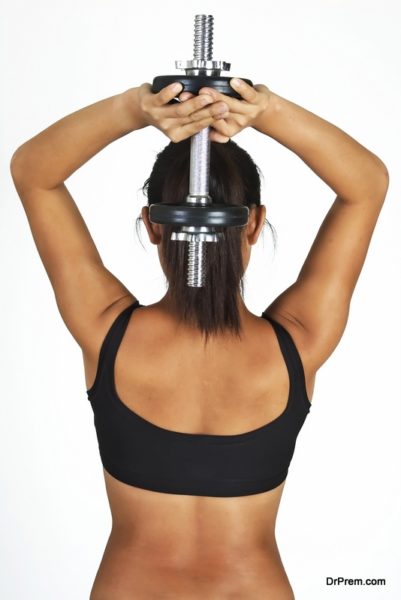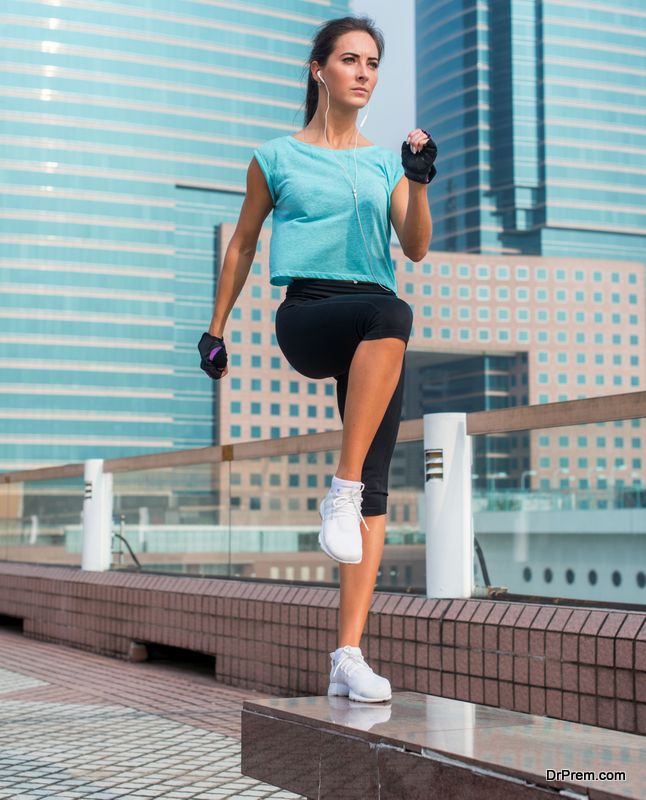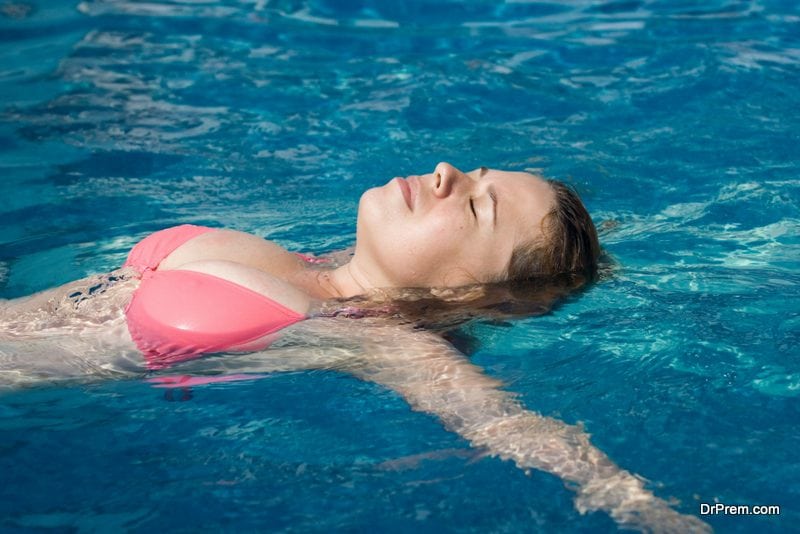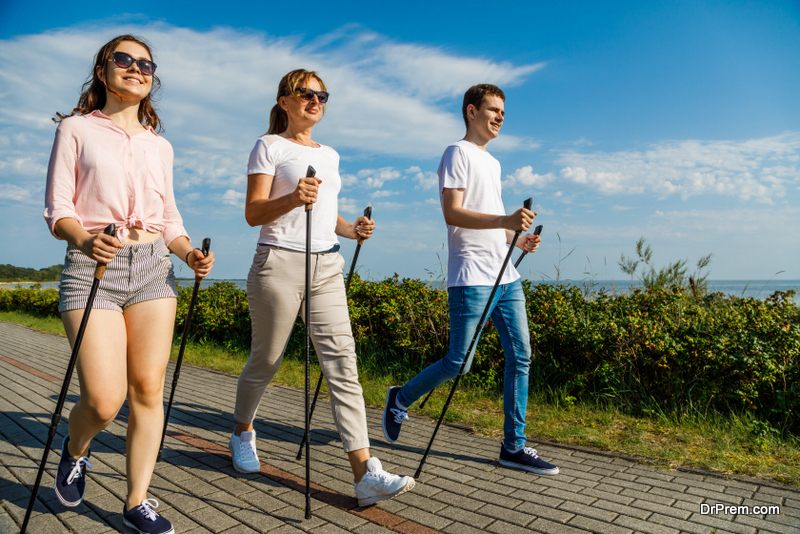Exercises are generally good for health. But certain ailments demand that we refrain from particular exercises, as they only aggravate the situation further. While exercising can be a relief for ankylosing spondylitis patients, there are some exercises which should be absent from our daily routine because they can be causes of injury and can hamper further recovery. It is, therefore, necessary to exercise safely. By avoiding the following 9 exercises one can train the body without running the risk of ankylosing spondylitis: bent over dumbell row, squats, seated overhead dumbbell press, deadlift, crunch cum sit-ups, reverse crunches, good morning, step up and lying torso twist.
Squats

Squats is an unsupported power movement which can be dangerous for the spine since the weight is divided on the posterior chain. Thus, it is very often associated to back injuries. Squats can be a cause of lumbar spine injuries which can aggravate the state of a person who is suffering from ankylosing spondylitis. However, a patient can perform supported squats as well as seated leg press which will develop the same muscles. Supported squats should be assisted by a trainer. It is advisable to receive the consent of a doctor before engaging in these exercises.
Bent over dumbbell row
The exercise targets the development of the latissimus dorsi mainly. Other back muscles are also involved in the movement. The exercise is performed by bending down and lifting dumbbells till chest height. However, the exercise can prove to be injurious if the spine is not maintained in an arch position or if the movement gives a jerk to the spine. This exercise can be practiced under the close supervision of a trainer who can assist the exercise if the patient is confident that arched back can be maintained throughout the exercise. The patient is also advised not to go for heavyweight dumbbells.
Seated overhead dumbbell press

Seated overhead dumbbell press exercise is performed by sitting on a bench and pushing the dumbbell from shoulder height till the elbows are locked. In this exercise, the weight-bearing joints are engaged. Therefore, the weight is divided on the spine. Ankylosing spondylitis patients cannot afford to bear the weight on their spine as it might turn out to be injurious. The exercise can be safer if practiced with a belt. However, this exercise, in general, is not medically advised for ankylosing spondylitis patients.
Lying torso twist
This exercise is performed by lying down on the floor, lifting the legs and rotating the legs towards one direction. Lying torso twist is not recommended. Researches conducted by medical professionals show that the movements involved in the torso twist do not go in accordance with the natural biomechanics of the lumbar spine. Thus, this exercise can prove to be more dangerous than beneficial to an ankylosing spondylitis patient. A patient can practice kickboxing or boxing after receiving medical consent since the activity works out the muscles around the torso every time a person punches, kicks or rotates. These activities should be carried out with extreme precautions.
Deadlift
 A deadlift is an exercise which involves lifting a weight from the floor by bending over. It also involves lowering the weight back to the floor. In this exercise the lower back, that is, the erector spinae work isometrically to prevent the back from rounding. However, this exercise runs the risk of a spinal disc herniation if there is spinal flexion. Moreover, it is difficult for ankylosing spondylitis patients to do the movements because of the weakness in their back muscles. Thus, it is not recommended to perform this exercise. Instead, prone alternate hand and leg raises can be performed for the benefit of the same muscles.
A deadlift is an exercise which involves lifting a weight from the floor by bending over. It also involves lowering the weight back to the floor. In this exercise the lower back, that is, the erector spinae work isometrically to prevent the back from rounding. However, this exercise runs the risk of a spinal disc herniation if there is spinal flexion. Moreover, it is difficult for ankylosing spondylitis patients to do the movements because of the weakness in their back muscles. Thus, it is not recommended to perform this exercise. Instead, prone alternate hand and leg raises can be performed for the benefit of the same muscles.
Good morning exercise
This exercise involves weightlifting. While exercising, it is required to keep a barbell on the trapezius and bend down. It is also required to move back in the neutral position and perform the action of bending down again. The erector spinae muscles found in the lower back work isometrically to keep the spine extended. This exercise can help the lower back if properly performed under the guidance of a trainer. However, it also runs the risk of injuries if the back is rounded by mistake.
Crunch cum sit up
 Crunch cum sit up exercise aims at strengthening the abs muscles and the hip flexors. The exercise is performed by lying down on the floor and then with hands locked behind the head or on the chest. The knees are kept bent. The upper body is then lifted from the ground and the action is repeated. It is not medically advised for patients of ankylosing spondylitis to perform this exercise due to high compressive lumbar load. The exercise can be replaced by partial crunch cum sit up exercises which are beneficial to the same muscles with lesser spine involvement.
Crunch cum sit up exercise aims at strengthening the abs muscles and the hip flexors. The exercise is performed by lying down on the floor and then with hands locked behind the head or on the chest. The knees are kept bent. The upper body is then lifted from the ground and the action is repeated. It is not medically advised for patients of ankylosing spondylitis to perform this exercise due to high compressive lumbar load. The exercise can be replaced by partial crunch cum sit up exercises which are beneficial to the same muscles with lesser spine involvement.
Reverse crunches
Reverse crunches workout the lower part of the abdominal. It is done by lying on the floor and lifting the lower body. The pelvis is rolled in this exercise and it involves trunk flexion. The lower body represents 60 percent of the total body weight which makes the exercise challenging. However, it is not recommended for ankylosing spondylitis patients. 30 degrees alternative leg raises/prone superman is safer.
Step up exercises
 Step up is a recommended exercise to improve functionality. It is not advisable for ankylosing spondylitis patients to perform this exercise with weight as it is a compound movement. This movement involves several muscles and hip joint. The lower back acts as a stabilizer. If the stabilizer is weak, injury can be caused in the lower back. However, this exercise can be performed in aerobic activities since it involves just the basic movement on low steps. However, it is necessary to receive the consent of a doctor before engaging in the exercise.
Step up is a recommended exercise to improve functionality. It is not advisable for ankylosing spondylitis patients to perform this exercise with weight as it is a compound movement. This movement involves several muscles and hip joint. The lower back acts as a stabilizer. If the stabilizer is weak, injury can be caused in the lower back. However, this exercise can be performed in aerobic activities since it involves just the basic movement on low steps. However, it is necessary to receive the consent of a doctor before engaging in the exercise.
Having ankylosing spondylitis doesn’t mean you simply have to give up on exercising. There are also exercises that would help you better manage the disease. Let’s take a look at seven such exercises.
Seven alternative exercises to reduce the symptoms of ankylosing spondylitis
1. Stand tall and chest expansion
 To fight ankylosing spondylitis, doctors ask patients to cultivate a habit of sitting, standing, and walking tall. This exercise is best suited to check the posture of the body. You can either stand against a wall or sit on a chair to perform this exercise. Just sit on a chair with your feet shoulder-width apart and balanced chin in front of a mirror. Keep your head steady and look straight by tilting your head a bit. Stretch your arms open and take a deep breath. As you inhale air, try rolling your arms back. As you stretch your arms, you will experience a stretch across your chest. As you bring your arms down, exhale slowly and let your palms turn back towards your legs. Repeat this stretch 2-4 times for 15 to 30 seconds each and gradually increase the frequency and time of stretch as you get used to it.
To fight ankylosing spondylitis, doctors ask patients to cultivate a habit of sitting, standing, and walking tall. This exercise is best suited to check the posture of the body. You can either stand against a wall or sit on a chair to perform this exercise. Just sit on a chair with your feet shoulder-width apart and balanced chin in front of a mirror. Keep your head steady and look straight by tilting your head a bit. Stretch your arms open and take a deep breath. As you inhale air, try rolling your arms back. As you stretch your arms, you will experience a stretch across your chest. As you bring your arms down, exhale slowly and let your palms turn back towards your legs. Repeat this stretch 2-4 times for 15 to 30 seconds each and gradually increase the frequency and time of stretch as you get used to it.
There are no side effects of this exercise except for mild muscle pain. This exercise helps in keeping a check on the growth of ankylosing spondylitis, erects your posture, increases muscle flexibility, and enhances blood circulation.
2. Prone lying
Lay face down on the floor. Keep a pillow under your forehead and chest. Keep the hands folded and place your head on them. Take deep breaths and stretch your body from head to toe. During the initial stages, try this exercise for two to five minutes session. Gradually you can extend the time accordingly.
Prone lying is considered as one of the best exercises to erect the body posture and reduce the effects of ankylosing spondylitis. It is an easy exercise and can be done at home or in a fitness center. Still, consultation with a physiotherapist is strictly recommended. During first week, you may experience muscle pain, which will soon vanish with time. This exercise increases the flexibility of the spinal muscles. Make sure that you do not lie on a cold floor as it can cause muscle pain. A warm up session prior to this exercise will do wonders in improving your overall fitness levels. Make sure you do this exercise properly, preferably under the supervision of a physician in the initial stages, just to ensure that you do not end up doing it the wrong way. Do not try this exercise during pregnancy and if you got a surgery done recently.
3. Swimming
 There are different swimming styles but back crawl is found to be most effective in fighting spinal ankylosing spondylitis disorder. In this kind of stroke when you push yourself forward, the neck as well as the spine rotates gently giving it the much-needed mild exercise. It also opens up the chest cavity and moves the shoulders in the anti-clockwise direction.
There are different swimming styles but back crawl is found to be most effective in fighting spinal ankylosing spondylitis disorder. In this kind of stroke when you push yourself forward, the neck as well as the spine rotates gently giving it the much-needed mild exercise. It also opens up the chest cavity and moves the shoulders in the anti-clockwise direction.
Several coveted medical institutions and research centers have established the fact that swimming is a very effective tool to fight the effects of ankylosing spondylitis. It reduces the possibility of inflammation of your joints considerably. Regular swimming increases the flexibility of the spine and provides good workout to the complete body. One should avoid butterfly stroke as it can strain the backbone. Do consult your doctors before you opt for swimming in case of chronic ankylosing spondylitis as some styles may put excessive strain on the neck, lower back and other body parts. Swimming provides whole workout session to the body. It increases the flexibility of the body and stretches all body parts to normal. It boosts your overall fitness level. Keep the time duration according to your stamina, as it can be tiring. Do not practice swimming during pregnancy, in case of a recent surgery, and severe ankylosing spondylitis.
4. Hip and back stretches
A person suffering from ankylosing spondylitis experiences pain as the muscles of hips, legs and back muscles get stiff which also ensues in postural changes. Doctors and physicians all over the world recommend hip, back and leg stretches to keep ankylosing spondylitis at bay. These stretches are easy and can be practiced at home after consulting with a trainer or a physical therapist to make sure that you perform it correctly. Try lying facedown on the floor. Keep your elbows bent with hand under the shoulders. Take a deep breath and gently press down with your arms in order to lift your shoulders off the floor.
Hold this position for around 5 seconds and go back to the original position slowly while exhaling. Repeat this exercise two to four times in the initial stages and gradually you can increase the frequency. Do not overdo it as it may cause muscular pain and muscle fatigue. In addition to this, you can also try getting down on your hands and knees while keeping your back and neck straight. Now, lift the leg behind you straight out and maintain the level of the hips. You can repeat this exercise two to four times with each leg and increase the sessions gradually with time.
Beginners can experience some fatigue and muscle pain in initial stages, which soon vanishes with time. Do not try these stretches in severe ankylosing spondylitis, arthritis, pregnancy, and recent surgery.
5. Breathing exercises
 To reduce the effects of stiffness in lungs and ribs, breathing exercise can be of great help. As muscles around the lungs become stiff, the capacity of the lungs also decreases considerably. Physicians all over the world recommend deep breathing exercise to deal with loss of mobility in spine and ribcage. Try deep breathing sessions preferably in morning. Stand still and take a deep breath while stretching your hands backward. Slowly release your breath as you move your hands back to the original position. In addition, sit in a position popularly known as the bound angle position with arms starched over your head.
To reduce the effects of stiffness in lungs and ribs, breathing exercise can be of great help. As muscles around the lungs become stiff, the capacity of the lungs also decreases considerably. Physicians all over the world recommend deep breathing exercise to deal with loss of mobility in spine and ribcage. Try deep breathing sessions preferably in morning. Stand still and take a deep breath while stretching your hands backward. Slowly release your breath as you move your hands back to the original position. In addition, sit in a position popularly known as the bound angle position with arms starched over your head.
It is very effective to stretch the chest and increase the lung capacity back to normal. There are no side effects of this exercise and anyone can try it. It increases the oxygen flow in blood with more air being inhaled in each breath. It aligns the body posture and brings down stress levels.
6. Prone arm and leg lifts
Prone arm and leg lifts is yet another exercise to ward off the ill effects of ankylosing spondylitis. Lie face down on your stomach and stretch your body as much as you can. Lift one arm and leg simultaneously and hold this position for around 10 seconds. Repeat this exercise with the other arm and leg while relaxing in between for few seconds. Make sure that you do not exert yourself too much as it may cause muscle pain and fatigue. If you feel uneasy, just place a pillow under your chest. It will help you avoid excessive arching of the backbone. For leg lifts, just push your knees against the floor and using your knees, raise your leg to a certain height. Hold this position for few seconds and bring down your legs slowly. The frequency can be increased with time.
During the initial phase, you may experience pain and cramps in arms and legs. If the pain gets unbearable, reduce the duration of exercise. Take rest and start again with small sessions. Do not perform the exercise in case of severe ankylosing spondylitis, arthritis, pregnancy, and recent surgery.
7. Nordic walking
 Brisk walking also known as Nordic walking offers several benefits that are generally overlooked by most of us. It not only helps in maintaining good fitness levels but also is an excellent way of toning muscles and increasing their flexibility. If you are suffering from ankylosing spondylitis, then Nordic walking is necessary for you, preferably in the morning hours.
Brisk walking also known as Nordic walking offers several benefits that are generally overlooked by most of us. It not only helps in maintaining good fitness levels but also is an excellent way of toning muscles and increasing their flexibility. If you are suffering from ankylosing spondylitis, then Nordic walking is necessary for you, preferably in the morning hours.
Walking increases the flow of oxygen in the body, which helps in reducing the stiffness of the muscles. However, running must be avoided as it can aggravate the condition, especially if it is severe ankylosing spondylitis. Nordic walking is said to reduce the muscle tension considerably along with the pain in the joints due to arthritis. This exercise can be exhausting so you should walk according to your stamina. Do not try this exercise in severe arthritis, spondylitis, and pregnancy.

